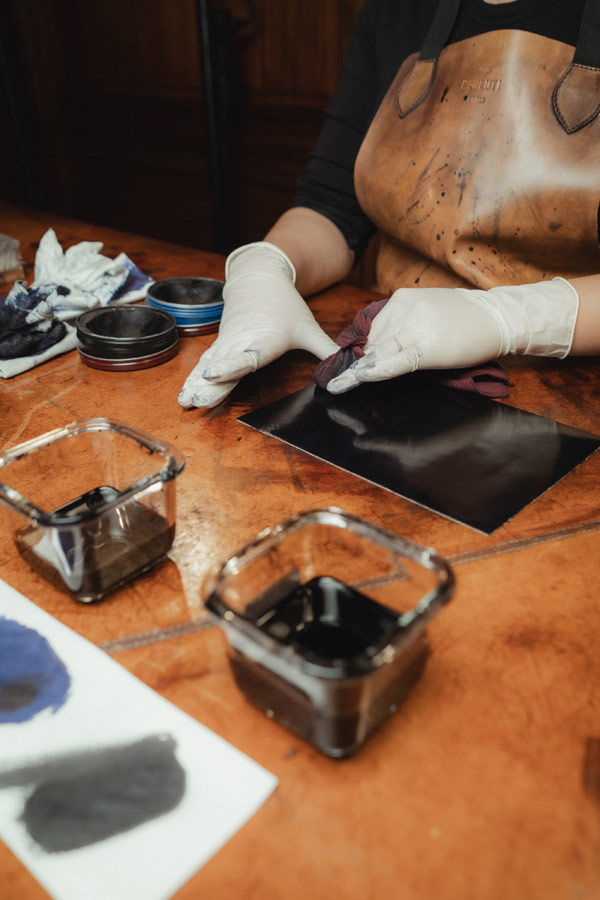








There is something about acquiring a brand new item. You feel excited opening the box and peeling away at the protective packaging to get to that freshly minted object you’ve been coveting. Heck, you may even treat it like a precious extension of your very self, protecting it from any possible aggressor as best you can. Alas, pristine perfection doesn’t endure. It cannot. Unless an item gets used only on very rare occasions, signs of wear are inevitable. The first cut (scratch, mark, scuff, etc.) is often the deepest, and then the novelty wears off, the rue and lament stop, and life goes on.
Berluti’s signature patina technique sidesteps this emotional transitioning rather elegantly with the idea that age is beautiful—not a flaw but a sign of earned excellence and formed character. Indeed, while a fresh pair of Oxfords free of creases and wholly drenched in a single tone speaks to masterful craftsmanship and attention to detail, it’s also akin to a blank canvas without much, if any, personality. A patinated pair on the other hand, imbues depth, even somewhat of a backstory—something that would otherwise take a great deal of time to develop naturally.

It all began with Olga Berluti. The granddaughter of Berluti founder, Alessandro Berluti, joined the family business in 1959 at the age of 20. Despite having shoemaking in her blood, Olga was not above doing the most menial of tasks. It is said that while she was dusting the shoes in the shop window one evening, she noticed how the moon affected the browns and blacks of the shoes. It reminded her of growing up as a child and how traditionally, washing was hung out to dry by the light of the moon in order to bleach them. Olga proceeded to learn more about the effect, researching and honing her knowledge before eventually starting her first patina.
But in order to give Berluti shoes that characteristically aged look, a proper canvas was needed for pigments of the patina to adhere to and one that promotes colour creativity. Olga developed Venezia leather by the 1990s as the answer. Venezia leather is a full-grain leather—selected only from hides of exceptional quality—that has undergone the brand’s special mineral and vegetable tanning processes to result in its unique suppleness as well as specific adhesive properties.
Skilled craftsmen start the process of adding the moon-kissed-effect colours on Venezia leathers only after they have been crafted into shoes. To prep the shoes for Berluti’s unique patina, they’re meticulously cleaned to remove everything from dust to superficial layers of shoe polish. They are then lightened with transparent polish and massaged using essential oils packed with natural pigments and waxes—talk about unguent care. The craftsmen then employ their honed skills and boundless imaginations to imbue each shoe with the character and personality of the patina. Playing around with tints and pigments using a range of brushes, sponges and cloths, each shoe is coloured to aged “perfection”, mimicking the fading effect of the moon’s rays. Subtle shades are blended with great nuance into one another to produce the effect of looking into the night sky.

Berluti patinas are like personalised signatures—individually distinct—and thus deserve to be named. Olga set the precedent by naming patina colours after seasons (Autumn Leaf), cities (Shanghai Night), and even a customer. The Saint-Emilion red—a deep, glossy shade of crimson that’s one of Berluti’s iconic patina colours—was named to celebrate a great Bordeaux vineyard and a loyal customer. And of course, the brand’s classic Tobacco brown as a tribute to the warm amber hue of the brand’s iconic Alessandro lace-ups of 1895.
While each patina is unique, there exist logs containing colour recipes and methods on how to achieve them so that each colour technique can be faithfully replicated. It’s how we know that Yves Saint Laurent’s commission was a very dark blue-brown, or that Olga was inspired to create the deep grey of Beluga and the anthracite of Sevruga for Armen Petrossian, whose family introduced caviar to the French.

Therein lies the allure of the Berluti patina. It’s not simply about ageing a pair of shoes—for the record, the Berluti patina can be applied to just about anything imaginable—but rather, a personalisation technique that bestows character, personality and elegance. It’s a work of art that transcends time and takes time to perfect and, at the end of the day, offers a glimpse into the future: a well-lived beauty.